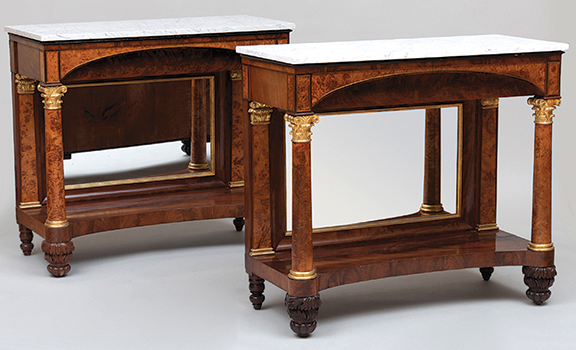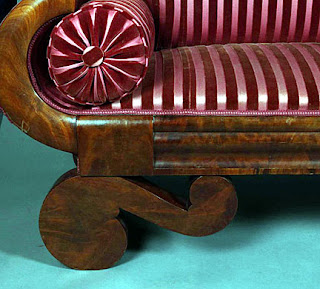 QUESTION: I like to visit historic houses. Invariably, the first stop is by a narrow table in the main hall. Next to it usually stands a hall tree. The docent usually begins by telling us that the women of the house would stand in front of this narrow table and adjust their petticoats using the mirror placed behind it. This seems like a plausible explanation. When and how did this practice begin? And why is the table called a “pier” table? According to the dictionary, a pier is a structure leading from the shore out to sea, used as a boat landing or for entertainment.
QUESTION: I like to visit historic houses. Invariably, the first stop is by a narrow table in the main hall. Next to it usually stands a hall tree. The docent usually begins by telling us that the women of the house would stand in front of this narrow table and adjust their petticoats using the mirror placed behind it. This seems like a plausible explanation. When and how did this practice begin? And why is the table called a “pier” table? According to the dictionary, a pier is a structure leading from the shore out to sea, used as a boat landing or for entertainment.
ANSWER: The English language can be complicated. There are many words that sound the same but are spelled differently and have different meanings. Over time, the word “peer,” meaning to look through a window with difficulty, may have been confused with the word “pier,” a seaside structure used for landing boats or for entertainment. Since most people coming to the United States in the 18th and 19th centuries spoke a different language—even British English was different than American English—it’s only natural that along the way, the two words got confused. It’s also likely that because a pier table juts out from the wall that it resembled a pier jutting out from the shore.
 Docents in historic houses always seem to have interesting stories about the furniture in them. One of these concerns the pier table. Supposedly, Southern women would stop in front of it and check the mirror below it to see if their petticoats were showing before going out. However, there are two things wrong with this story. First, the table did not appear primarily in the South, and second, women of the 19th century did no such thing. A woman of the time wouldn’t have been caught dead adjusting her undergarments in a public area of her house. Besides that, the architecture of the table, with the top projecting forward, well out over the mirror, prevents anyone, male or female from actually seeing beyond the area of their feet.
Docents in historic houses always seem to have interesting stories about the furniture in them. One of these concerns the pier table. Supposedly, Southern women would stop in front of it and check the mirror below it to see if their petticoats were showing before going out. However, there are two things wrong with this story. First, the table did not appear primarily in the South, and second, women of the 19th century did no such thing. A woman of the time wouldn’t have been caught dead adjusting her undergarments in a public area of her house. Besides that, the architecture of the table, with the top projecting forward, well out over the mirror, prevents anyone, male or female from actually seeing beyond the area of their feet.
So what exactly is a pier table? Simply, it’s a low, usually narrow table that stands in the pier, or wall section between two windows, often in the parlor of a wealthier person’s house. Cabinetmakers often made them in pairs of expensive woods, such as mahogany, rosewood, and giltwood. Unfortunately, ill informed curators of historic homes—originally wealthy women who joined groups who raised money to restore and manage historic homes—had heard the story of the pier table and placed it in the main hall where it didn’t belong in the first place.
The pier table first appeared in continental Europe in the 16th and 17th centuries and became popular in England in the last quarter of the 17th century. The first known use of such a table in America was in 1765 and remained popular until the mid 19th century.
 During the Regency Period from 1800 to 1830, a pier table had a mirror mounted between its back legs against the wall, or sometimes above it. The purpose of the mirror was to reflect the light around the room, not to check petticoats. The mirrors were often slightly angled towards the ceiling in order to catch as much light as possible, thus precipitating the fictional account. The extensive use of concave looking glasses in the 18th century and mirrors in the 19th century bounced the dim light from oil lamps around the room, increasing overall brightness. The mirror also reflected the pattern in the tile or carpet and helped make the room feel larger.
During the Regency Period from 1800 to 1830, a pier table had a mirror mounted between its back legs against the wall, or sometimes above it. The purpose of the mirror was to reflect the light around the room, not to check petticoats. The mirrors were often slightly angled towards the ceiling in order to catch as much light as possible, thus precipitating the fictional account. The extensive use of concave looking glasses in the 18th century and mirrors in the 19th century bounced the dim light from oil lamps around the room, increasing overall brightness. The mirror also reflected the pattern in the tile or carpet and helped make the room feel larger.
Eventually, pier tables became symbols of wealth. Reflecting light around a room on highly-polished surfaces, including mirrors, glass, crystal pendants on chandeliers, or fine wood surfaces, was a way of demonstrating wealth. It dazzled the eye and demonstrated a great deal of labor from servants who maintained that high degree of cleanliness.
 At the beginning of the 19th century, cabinetmakers around Philadelphia usually produced pier tables in the Chippendale style. They used Chippendale’s English design and traditional construction techniques since most had been trained by English cabinetmakers. The table became an American staple in larger homes during the Federal Period in the early 19th century, primarily in the Northern states, not in the South.
At the beginning of the 19th century, cabinetmakers around Philadelphia usually produced pier tables in the Chippendale style. They used Chippendale’s English design and traditional construction techniques since most had been trained by English cabinetmakers. The table became an American staple in larger homes during the Federal Period in the early 19th century, primarily in the Northern states, not in the South.
 The most commonly seen example of the table is in the Classical style of the early 1800s, usually with a marble top and columns of some sort—often also marble—at each corner supporting the heavy top. But why a marble top on a hall table? These tables were almost always 30-inches high, the exact height of a dining room table. As such, they could be used in the dining room as an extra serving space without fear of damage from hot plates on the marble top.
The most commonly seen example of the table is in the Classical style of the early 1800s, usually with a marble top and columns of some sort—often also marble—at each corner supporting the heavy top. But why a marble top on a hall table? These tables were almost always 30-inches high, the exact height of a dining room table. As such, they could be used in the dining room as an extra serving space without fear of damage from hot plates on the marble top.
The pier table reached it decorative zenith in the Empire period of the 1820s at the hands of such designers as Charles Honoré Lannuier, Thomas Hope and Joseph Meeks. The use of gilded caryatids—winged, female figures from Greek architecture—were frequently used as columns. Meeks used a set of lyres at each end to support the top.
 One of the greatest designers of pier tables was French ébéniste Charles-Honoré Lannuier, who emigrated in 1803 and became one of the leading furniture makers in New York. Trained in Paris, he rose to fame during the American Federal Period. After the Revolutionary War and War of 1812, anti-English sentiment made French goods especially appealing to Americans. Lannuier imported French pattern books to keep abreast of the latest Napoleonic style. His work featured robustly carved and gilded caryatid supports, carved dolphin feet, and elaborate gilt-bronze ormolu mounts. And while not every wealthy person could afford a Lannuier pier table, his tables reached the height of design excellence in the first two decades of the 19th century.
One of the greatest designers of pier tables was French ébéniste Charles-Honoré Lannuier, who emigrated in 1803 and became one of the leading furniture makers in New York. Trained in Paris, he rose to fame during the American Federal Period. After the Revolutionary War and War of 1812, anti-English sentiment made French goods especially appealing to Americans. Lannuier imported French pattern books to keep abreast of the latest Napoleonic style. His work featured robustly carved and gilded caryatid supports, carved dolphin feet, and elaborate gilt-bronze ormolu mounts. And while not every wealthy person could afford a Lannuier pier table, his tables reached the height of design excellence in the first two decades of the 19th century.
 After the Empire period, the Late Classicism style prevailed in the 1840s and 1850s with its large cyma curves, scrolled supports and undecorated expanses of crotch-cut mahogany veneer. This is the table that was frequently associated with the Southern plantation and the petticoat myth.
After the Empire period, the Late Classicism style prevailed in the 1840s and 1850s with its large cyma curves, scrolled supports and undecorated expanses of crotch-cut mahogany veneer. This is the table that was frequently associated with the Southern plantation and the petticoat myth.
After the Civil War, the pier table came to be known as a console table, and that’s when it began appearing in the foyers and front hallways of houses of the wealthy. Generally speaking, console tables stood higher than their pier table counterparts. They also usually didn’t have mirrors behind them as lighting technology had greatly improved since the beginning of the 19th century.
To read more articles on antiques, please visit the Antiques Articles section of my Web site. And to stay up to the minute on antiques and collectibles, please join the over 30,000 readers by following my free online magazine, #TheAntiquesAlmanac. Learn more about "The Age of Photography" in the 2023 Holiday Edition, online now. And to read daily posts about unique objects from the past and their histories, like the #Antiques and More Collection on Facebook.























